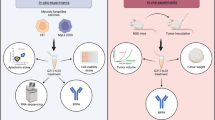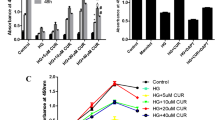Abstract
In vascular smooth muscle cells (VSMCs), induction of the heme oxygenase-1 (HO-1) confers vascular protection against cellular proliferation mainly via its up-regulation of the cyclin-dependent kinase inhibitor p21(WAF1/CIP1) that is involved in negative regulation of cellular proliferation. In the present study, we investigated whether the phytochemical curcumin and its metabolite tetrahydrocurcumin could induce HO-1 expression and growth inhibition in rat VSMCs and, if so, whether their antiproliferative effect could be mediated via HO-1 expression. At non-toxic concentrations, curcumin possessing two Michael-reaction acceptors induced HO-1 expression by activating antioxidant response element (ARE) through translocation of the nuclear transcription factor E2-related factor-2 (Nrf2) into the nucleus and also inhibited VSMC growth triggered by 5% FBS in a dose-dependent manner. In contrast, tetrahydrocurcumin lacking Michael-reaction acceptor showed no effect on HO-1 expression, ARE activation and VSMC growth inhibition. The antiproliferative effect of curcumin in VSMCs was accompanied by the increased expression of p21(WAF1/CIP1). Inhibition of VSMC growth and expression of p21(WAF1/CIP1) by curcumin were partially, but not completely, abolished when the cells were co- incubated with the HO inhibitor tin protoporphyrin. In human aortic smooth muscle cells (HASMCs), curcumin also inhibited growth triggered by TNF-α and increased p21(WAF1/CIP1) expression via HO-1-dependent manner. Our findings suggest that curcumin has an ability to induce HO-1 expression, presumably through Nrf2-dependent ARE activation, in rat VSMCs and HASMCs, and provide evidence that the antiproliferative effect of curcumin is considerably linked to its ability to induce HO-1 expression.
Similar content being viewed by others
Article PDF
Author information
Authors and Affiliations
Rights and permissions
This is an Open Access article distributed under the terms of the Creative Commons Attribution Non-Commercial License (http://creativecommons.org/licenses/by-nc/3.0/) which permits unrestricted non-commercial use, distribution, and reproduction in any medium, provided the original work is properly cited.
About this article
Cite this article
Pae, HO., Jeong, GS., Jeong, SO. et al. Roles of heme oxygenase-1 in curcumin-induced growth inhibition in rat smooth muscle cells. Exp Mol Med 39, 267–277 (2007). https://doi.org/10.1038/emm.2007.30
Published:
Issue date:
DOI: https://doi.org/10.1038/emm.2007.30
Keywords
This article is cited by
-
A review on heme oxygenase-1 induction: is it a necessary evil
Inflammation Research (2018)
-
Antioxidant and vascular protective effects of curcumin and tetrahydrocurcumin in rats with l-NAME-induced hypertension
Naunyn-Schmiedeberg's Archives of Pharmacology (2011)
-
Neferine inhibits angiotensin II-stimulated proliferation in vascular smooth muscle cells through heme oxygenase-1
Acta Pharmacologica Sinica (2010)
-
Hormetic Dietary Phytochemicals
NeuroMolecular Medicine (2008)



